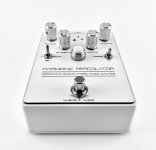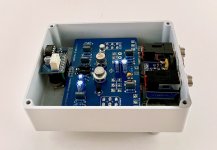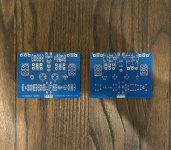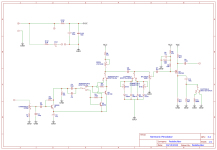PedalBuilder
Well-known member
- Build Rating
- 5.00 star(s)
Here's my take on the classic Interfax Harmonic Percolator. I'll lead with the pictures of the build; the full write-up is below the last picture.




Background
I had always been kinda meh about building a harmonic percolator until I heard this demo of the Latent Lemon's Hurts:
The gnarly octave down fuzz in that video got me off of the fence, but also presented a challenge—how to make a harmonic percolator that had such a strong octave down? I'd breadboarded the Albini and Giblet circuits a couple of years ago, but didn't remember hearing even slightest hint of a lower octave. I searched to Reddit and the usual forums, but the results were vague and contradictory, so I pulled out my breadboard and decided to find out for myself.
I'll spare you all the full details of the trial and error process that went into figuring this out, so here are my main findings on how to make a harmonic percolator with a strongly pronounced octave down:
So, now that I'd figured out how to make a harmonic percolator with a lower octave, it was time to figure out what else I wanted to include in my build.
Modifications
In a way, you could view this post is an entry in the Dreaded Diode Debate. I liked the idea of adding a diode switch to go between Germanium, Silicon, and no diodes, but I did not like the massive changes in volume that went along with changing the diode type. I wanted the diode switch to act more like a compression/lower distortion/octave intensity switch, rather than a volume boost switch. I was also a little irritated by the low output volume that came along with the D310 diodes.
To solve this issue, I tacked on an AMZ Mosfet boost to the tail end of the circuit. Rather than using an SPDT switch for the diodes, I used a DPDT On-Off-On switch. One pole was used to switch the diodes—germanium, none, and silicon. The other pole was used to switch a resistor in parallel with the source resistor bypass capacitor's series resistor (now say that three times fast). When set to germanium, the source bypass capacitor was connected to ground; when set to none, the bypass capacitor's series resistor was not paralleled, and when set to silicon, the series resistor was paralleled by a 590Ω resistor. As a result, I could now switch diodes without any change in the output level of the pedal.
Other modifications:
The Triode switch lets you change the Q2 transistor. I used a BC109 with an hFE of 240 for the silicon, and an MP35 with an hFE of 53 and a leakage of 50µA for the germanium. I tried a couple of higher gain germanium transistors—a Motorola house number with an hFE around 100 and a Texas Instruments house number with an hFE around 150, both with under 50µA of leakage. The higher gain transistors sounded mushier, for lack of a better term, so I went with the MP35. The switch includes the collector-base feedback resistor, as I preferred different values for the silicon and germanium transistors. The germanium transistor has none of the lower octave undertones; it's brighter and gets gated and spitty at lower settings of the voltage control.
The Symmetry knob lets you add up to 4.7kΩ of resistance in series with one side of the clipping diodes. As I mentioned earlier, adding resistance in series with one of the diodes produces clipping asymmetry, at the cost of making the lower octave less prominent. I found that I liked different amounts asymmetry for different types of tones, so I decided to make that resistor into a potentiometer. Turning the knob up increases the symmetry by decreasing the resistor value. To accommodate diode switching, I had to use a dual ganged pot pot. I experimented with this feature on the breadboard, and found that any more than ~5kΩ serial of resistance didn't do much. Unfortunately Tayda doesn't stock dual B5k pots, so I created my own. I took a dual B10k pot and soldered 10kΩ resistors across the pot lugs through the rivets that hold the lugs onto the phenolic wafer. There's a nice series of articles on @Amplified Parts' website that explains how this works.
As explained above, the Voltage knob decreases the Q2 collector resistance, letting you tune the location of the lower octave. It also changes the character of the distortion, spittier at lower values, and smoother as the knob is turned up and the collector voltage increases.
The Harmonics knob is largely the same as the stock harmonic percolator. I added a 1kΩ resistor in between potentiometer terminal 1 and ground so that it still passes signal even when the knob is turned all the way down.
Other Notes
Here are the transistor voltages with the voltage knob turned all the way up:
Q1E - 2.63
Q1B - 2.48
Q1C - 1.85
Q2E - 2.39
Q2B - 2.77
Q2C - 3.95
Q3E - 2.65
Q3B - 2.71
Q3C - 3.3
Current consumption of the core circuit (excluding the LED and relay bypass board) was 1.4mA.
The I/O breakout board provides reverse polarity and over-voltage protection (more on that here), so there's no series diode polarity protection on the board.
The footswitch board has a small microcontroller-based relay bypass circuit with the usual features (momentary bypass, remembering bypass state, etc.).
The faceplate is a white-on-black faceplate manufactured by Spencer at @amplifyfun. I paired it with a Tayda white sand 1590BB2 enclosure.
The LED is a 10mm white LED inside of a white jewel lens. The lens dulls the light significantly, so I had to get aggressive with the LED resistor. I usually use a 15kΩ resistor with modern ultrabright LEDs, but I had to go all the way down to 750Ω to get to a comparable level of brightness here.
I got the knobs from Stomp Box Parts, and they were the only disappointment in this project. The knobs' inside diameter is about .3 mm larger than the 6.35mm potentiometer shaft, so they wobble when handled and don't appear centered when turned. Normally their stuff is top notch, but these appear to be the exception.
And finally, here is the schematic:





Background
I had always been kinda meh about building a harmonic percolator until I heard this demo of the Latent Lemon's Hurts:
The gnarly octave down fuzz in that video got me off of the fence, but also presented a challenge—how to make a harmonic percolator that had such a strong octave down? I'd breadboarded the Albini and Giblet circuits a couple of years ago, but didn't remember hearing even slightest hint of a lower octave. I searched to Reddit and the usual forums, but the results were vague and contradictory, so I pulled out my breadboard and decided to find out for myself.
I'll spare you all the full details of the trial and error process that went into figuring this out, so here are my main findings on how to make a harmonic percolator with a strongly pronounced octave down:
- Low hFE, low leakage Q1. I settled on a Texas Instruments house number that's comparable to a 2N404 or 2N1303, with an hFE of 47 and less than 10µA of leakage, but low leakage transistors with an hFE anywhere from 40 to 70 seemed to work best.
- Adjust the Q2 collector-base feedback resistor to dial in the lower octave. I started off with a 750kΩ resistor, and incrementally increased it. The octave started being noticeable by the time I got to a 1.2MΩ resistor, and became more noticeable as I increased the value. At a certain point the lower octave starts to fade away; using a 2.7MΩ resistor had a very strong lower octave, but a 3.9MΩ resistor had virtually none. I didn't have any resistors with intermediate values, so I used a 2.7MΩ resistor in my build.
- Adjust the Q2 collector resistor to tune the range of the lower octave. The lower octave is most noticeable within a roughly one octave range. You can change the location of this range by changing the Q2 collector resistor. As you can see from the pictures, my build includes a voltage control. It's a 250kΩ potentiometer in series with a 62kΩ resistor. When set for maximum resistance, around 315kΩ, the lower octave starts at an open low E flat on a guitar that's tuned half a step down. Decreasing the resistance shifts the lower octave further down the fretboard. By the time the resistance is at 62kΩ, the lower octave is about one octave lower than it was originally, and the voltage on the collector resistor is about double what it was at maximum resistance.
- Use very low Vf diodes. Like the super fuzz, the clipping diodes don't create the octave overtones, but they do make them a lot more noticeable. Lowering the Vf of the diodes makes a huge difference in the prominence of the octave. I used some Soviet D310 diodes that had a crazy low Vf—just 0.17v on my Fluke. You could probably just use 1N5817s or another very low Vf Schottky instead—just note that the oversized diodes look way cooler. I also tried D9 and D18 diodes, but the .1v increase in Vf resulted in a significant decrease in the prominence of the lower octave.
- Symmetrical clipping produces a clearer lower octave. The harmonic percolator has a 4.7kΩ resistor in series with one of the clipping diodes to produce asymmetrical clipping. Reducing or, ideally, eliminating the resistor makes the lower octave more prominent.
- Q1 Vbe seems to matter? The Texas Instruments transistor had a Vbe of 0.319. Replacing it with a GT308B with identical gain/leakage measurements, but a Vbe of 0.425 completely removed the lower octave. In retrospect, it seems intuitive that Vbe would matter in this circuit, given the shared bias current between the two transistors, but it's not a spec that I see get much discussion.
So, now that I'd figured out how to make a harmonic percolator with a lower octave, it was time to figure out what else I wanted to include in my build.
Modifications
In a way, you could view this post is an entry in the Dreaded Diode Debate. I liked the idea of adding a diode switch to go between Germanium, Silicon, and no diodes, but I did not like the massive changes in volume that went along with changing the diode type. I wanted the diode switch to act more like a compression/lower distortion/octave intensity switch, rather than a volume boost switch. I was also a little irritated by the low output volume that came along with the D310 diodes.
To solve this issue, I tacked on an AMZ Mosfet boost to the tail end of the circuit. Rather than using an SPDT switch for the diodes, I used a DPDT On-Off-On switch. One pole was used to switch the diodes—germanium, none, and silicon. The other pole was used to switch a resistor in parallel with the source resistor bypass capacitor's series resistor (now say that three times fast). When set to germanium, the source bypass capacitor was connected to ground; when set to none, the bypass capacitor's series resistor was not paralleled, and when set to silicon, the series resistor was paralleled by a 590Ω resistor. As a result, I could now switch diodes without any change in the output level of the pedal.
Other modifications:
The Triode switch lets you change the Q2 transistor. I used a BC109 with an hFE of 240 for the silicon, and an MP35 with an hFE of 53 and a leakage of 50µA for the germanium. I tried a couple of higher gain germanium transistors—a Motorola house number with an hFE around 100 and a Texas Instruments house number with an hFE around 150, both with under 50µA of leakage. The higher gain transistors sounded mushier, for lack of a better term, so I went with the MP35. The switch includes the collector-base feedback resistor, as I preferred different values for the silicon and germanium transistors. The germanium transistor has none of the lower octave undertones; it's brighter and gets gated and spitty at lower settings of the voltage control.
The Symmetry knob lets you add up to 4.7kΩ of resistance in series with one side of the clipping diodes. As I mentioned earlier, adding resistance in series with one of the diodes produces clipping asymmetry, at the cost of making the lower octave less prominent. I found that I liked different amounts asymmetry for different types of tones, so I decided to make that resistor into a potentiometer. Turning the knob up increases the symmetry by decreasing the resistor value. To accommodate diode switching, I had to use a dual ganged pot pot. I experimented with this feature on the breadboard, and found that any more than ~5kΩ serial of resistance didn't do much. Unfortunately Tayda doesn't stock dual B5k pots, so I created my own. I took a dual B10k pot and soldered 10kΩ resistors across the pot lugs through the rivets that hold the lugs onto the phenolic wafer. There's a nice series of articles on @Amplified Parts' website that explains how this works.
As explained above, the Voltage knob decreases the Q2 collector resistance, letting you tune the location of the lower octave. It also changes the character of the distortion, spittier at lower values, and smoother as the knob is turned up and the collector voltage increases.
The Harmonics knob is largely the same as the stock harmonic percolator. I added a 1kΩ resistor in between potentiometer terminal 1 and ground so that it still passes signal even when the knob is turned all the way down.
Other Notes
Here are the transistor voltages with the voltage knob turned all the way up:
Q1E - 2.63
Q1B - 2.48
Q1C - 1.85
Q2E - 2.39
Q2B - 2.77
Q2C - 3.95
Q3E - 2.65
Q3B - 2.71
Q3C - 3.3
Current consumption of the core circuit (excluding the LED and relay bypass board) was 1.4mA.
The I/O breakout board provides reverse polarity and over-voltage protection (more on that here), so there's no series diode polarity protection on the board.
The footswitch board has a small microcontroller-based relay bypass circuit with the usual features (momentary bypass, remembering bypass state, etc.).
The faceplate is a white-on-black faceplate manufactured by Spencer at @amplifyfun. I paired it with a Tayda white sand 1590BB2 enclosure.
The LED is a 10mm white LED inside of a white jewel lens. The lens dulls the light significantly, so I had to get aggressive with the LED resistor. I usually use a 15kΩ resistor with modern ultrabright LEDs, but I had to go all the way down to 750Ω to get to a comparable level of brightness here.
I got the knobs from Stomp Box Parts, and they were the only disappointment in this project. The knobs' inside diameter is about .3 mm larger than the 6.35mm potentiometer shaft, so they wobble when handled and don't appear centered when turned. Normally their stuff is top notch, but these appear to be the exception.
And finally, here is the schematic:

Last edited:



